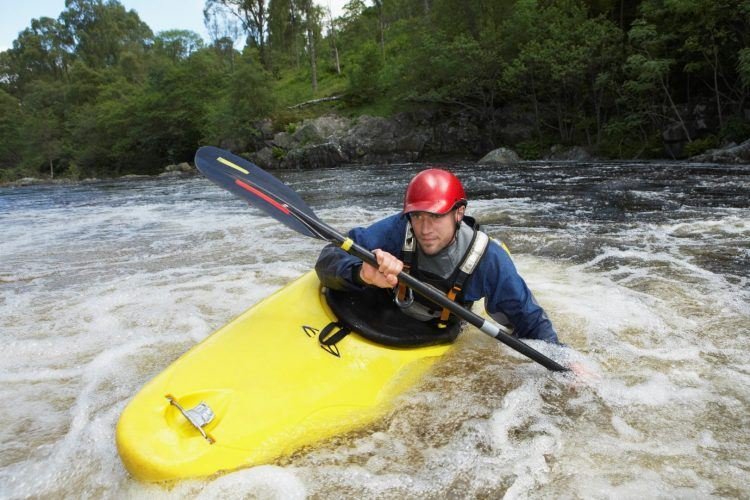It’s a question that often comes to the minds of those who are new to the sport (and their significant other) – how dangerous is kayaking? Unfortunately, the answer is not simple. There are so many different styles of kayaking, and each comes with their set of dangers.
However, most of the dangers can be mitigated through careful preparation and knowing your limits; recognizing the risks inherent in the sport will keep you safe.
How Dangerous Is Kayaking (6 Recommendations)
1. Drowning
The most obvious risk with kayaking is, of course, drowning; you trust a relatively small plastic or inflatable boat to keep your head above water, even as you paddle through gnarly whitewater holes or massive ocean waves. You have to rely on your ability to read the water and know where to paddle the boat to keep you safe (avoid those strainers at all cost!).
Should everything go wrong though, you can rest assured that your personal flotation device (PFD), aka, lifejacket, will keep you afloat until you can swim to a safer area or be rescued by a paddling partner. There are limits to what a PFD can do for flotation though; whitewater holes and large waves can still drag you underwater.
That being said, wearing your PFD on every outing can save your life, so be sure to choose one that’s comfortable for you.
2. Collision with Rocks
This is a bigger concern for whitewater paddlers, as they have to maneuver through boulder fields, which other kayakers would avoid. Kayakers can get pinned against these boulders, and the risk of hitting your head as you paddle out of this situation is high.
A blow to the unprotected head can result in a concussion, unconsciousness, and even death. Even if the hit doesn’t cause permanent damage, it can certainly be enough to impair your judgment temporarily, and you will need all of your mental faculties to make it down the river.
A quality helmet will protect you from an incident like this. Though they may look like bike helmets, they are specially designed to protect your head against the kind of blows that paddlers are most likely to experience. If you’re a whitewater kayaker, you should wear a helmet on every outing.

3. Exposure to the Sun
Nowhere are you more exposed to the sun than on the open water, where punishing UV rays are beating down on you at all times. Unless you’re one of the few who’ve outfitted their kayak with a canopy, there won’t be much in between you and that damaging ultraviolet light.
The dangers of sun exposure are enhanced on the water, as it can reflect ultraviolet radiation in a way that solid ground might not. Your risk of exposure to sunlight isn’t just from above, but from all sides and even below.
To protect yourself from sunburns, skin cancer, and heatstroke, your first line of defense will be your clothing. The kayak cockpit and sprayskirt will cover much of your body, assuming you’re not paddling a sit-on-top, but you should cover up any remaining skin with a shirt or rash guard and a wide-brimmed hat.
Put sunscreen on the skin that can’t be covered, and apply liberally and often, especially if you’re a sea kayaker, since salt water quickly removes the lotion. Many people forget that their lips are susceptible to UV rays too, so be sure to apply protective lip balm prior to your paddling adventure.
4. Dehydration
You might be surrounded by water, but it’s almost certainly unsafe to drink. Whether you’re paddling through salt water or through fresh water filled with parasites, you cannot drink it, so you need to bring along your own water source.
You should always carry a good-sized water bottle with you, and take drinks from it often. Depending on how hot it is, you might need a liter per hour.
Caffeine and alcohol act as diuretics and will hasten the onset of dehydration, it’s best to avoid them entirely. Sugary drinks might provide some energy, but they’re not the most hydrating, so sticking to plain water is ideal.
Some paddlers cut back on their water consumption because they’re worried about where they are going to urinate, which is never a smart choice. Bathroom options include the water around you (great time to practice a self-rescue after relieving yourself) or you could urinate in a bottle (ladies can do it too!).

5. Exhaustion
This one is all about knowing your limits. Simply put, don’t plan a trip that is more strenuous than you can handle. There’s nothing wrong with pushing yourself, but you need to have the strength to make it back to your car at the end of the day.
River and tidal currents are perhaps the biggest threat when it comes to an exhausting trip, because they’re often changing and aren’t easy to predict when planning an outing.
If you’re a sea kayaker, you should have a general idea of the strength of the tidal currents and always check a tide table before you put your boat in the water. If you plan to return at high tide, the currents can actually assist you. In the event that you end up in a really bad situation and get stranded too far from shore, having a VHF radio to call for help can save your life.
For river kayakers using a single vehicle, you’ll have to paddle both upstream and downstream to complete your trip. It’s safest to paddle upstream first, then if you’re tired on the return trip, at least you can use the currents to help you get back to your vehicle. Check the water levels in the river you plan to paddle, as their flow rates change throughout the season.
6. Lightning
You do not want to get caught on the open water during a thunderstorm. As soon as you hear thunder, start paddling towards the shore. Once you’re out of the water, the safest place to seek shelter is inside a building or a car (its metal exterior will direct the electricity around the vehicle, not through it).
If you’re unable to get off the water before the storm reaches you, the best thing to do is lie down as low in your kayak as possible; lightning is most likely to strike the highest point in the area, so you do not want to be that point. Most importantly, do not hold your paddle up in the air, as it would be a prime target for a lightning strike.
Of course, the best option is to avoid this potentially deadly scenario in its entirety; always check the weather before you set off on a paddling trip. Some days are just better spent indoors.
Mitigating the Dangers
So how dangerous is kayaking? Ultimately it’s as dangerous as you make it.
- The risks increase if you choose to paddle in remote locations, far from help.
- If you come unprepared and/or try to tackle waters you’re too inexperienced for, the chances of injury are higher.
- Take the time to plan your trips carefully. Don’t do spur-of-the-moment paddles.
- Keep a checklist of the gear that you’ll need for different paddling conditions, and consult it before every trip.
- Always be conservative in your judgment. Don’t plan your trips to test your physical limits.
- Wear a lifejacket during every trip, and a helmet if you’re whitewater kayaking.

